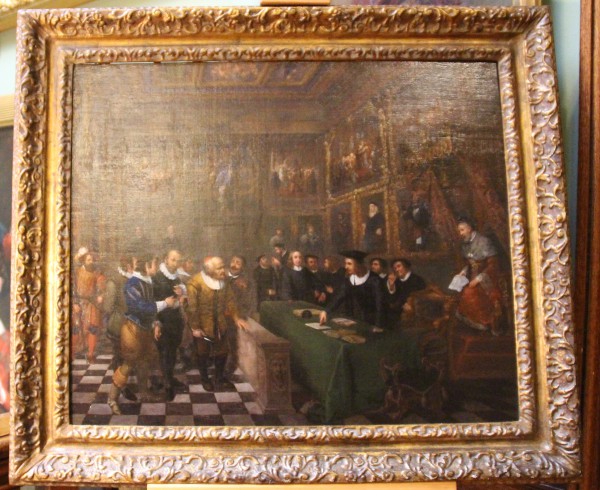Home
/
G1215
Paintings: G1215
Title
A scene from 'The Merchant of Venice'
Artist
Angelis, Peter
Date
c.1720
Dimensions
height: 95cm
width: 82cm
width: 82cm
Provenance
Sale, Frederik Muller / Mensing and Son, Amsterdam, 2-5 December 1941, lot 802 (as Troost: 700 florins) (NB. Item sold in a lot seperate to the May-Fuld collection which were lots 369-433, see Art Loss register cert 20 March 2020).
Sale, Muller, Amsterdam, 27 February 1968, lot 467 (as Troost).
Other number
E0084
This painting depicts the trial scene from Shakespeare's 'The Merchant of Venice'. The artist has set the scene in a hall inspired by the Doge's palace in Venice. Shylock, wearing a yellow jerkin and red yamulkah, holds his knife out ready to extract the pound of flesh from Antonio (wearing a black suit with white ruff). Basiano is seen to the right of Antonio clutching the money that is owed to Shylock. Portia dressed as the young lawyer, stand with her finger pointing at the contract, while Nerissa, her maid, also dressed as a young male lawyer watches on from the other end of the table. It is thought the scene depicted is Act IV, scene I, 11, 319-320, with Portia's lines:
"Tarry a little, there is something else
This bond doth give thee here no jot of blood".
This painting was previously attributed to Cornelis Troost, but Angelis' signature was found in the bottom right corner, having been apparently deliberately covered up some time in the 19th century.
It is not known why or for whom this painting was executed. Apart from the first recorded performance by the King's Company on February 10, 1605, and a command performance for the King the following Tuesday, there are no other recorded performances of 'The Merchant of Venice' in England in the 17th century. In the early 18th century Shakespeare's play was adapted by George Granville (later first Lord Lansdowne 1666-1735). His version 'The Jew of Venice' was published and performed in 1701, at Lincoln's Inn Fields probably in May of that year. At that time the play was considered a comedy. In Granville's trial scene Bassanio tries to insist on the pound of flesh coming from him, instead of Antonio, and draws his sword before being retrained by the guards, before Portia notes that the contract makes no mention of dropping blood.
This painting seems to therefore represent Shakespeare's own text. It is also thought that this painting does not represent an actual performance, but an imagined scene using Shakespeare's text as a guide.
The current theory is that this painting was painted in England during the years that Pieter Angelis spent here. The size of the canvas, is a standard size used in England at this time (25 x 30 inches), and conforms to other paintings Angelis made in England at this time. Angelis had arrived in England by 1719 until 1727 when he left for Rome.
If the the hypothesis is correct, that would make this painting the earliest known painting of a Shakespearian scene, pre-dating Hogarth's scene from 'The Tempest' (Nostell Priory, National Trust) of c.1734/5, by some fifteen years.
"Tarry a little, there is something else
This bond doth give thee here no jot of blood".
This painting was previously attributed to Cornelis Troost, but Angelis' signature was found in the bottom right corner, having been apparently deliberately covered up some time in the 19th century.
It is not known why or for whom this painting was executed. Apart from the first recorded performance by the King's Company on February 10, 1605, and a command performance for the King the following Tuesday, there are no other recorded performances of 'The Merchant of Venice' in England in the 17th century. In the early 18th century Shakespeare's play was adapted by George Granville (later first Lord Lansdowne 1666-1735). His version 'The Jew of Venice' was published and performed in 1701, at Lincoln's Inn Fields probably in May of that year. At that time the play was considered a comedy. In Granville's trial scene Bassanio tries to insist on the pound of flesh coming from him, instead of Antonio, and draws his sword before being retrained by the guards, before Portia notes that the contract makes no mention of dropping blood.
This painting seems to therefore represent Shakespeare's own text. It is also thought that this painting does not represent an actual performance, but an imagined scene using Shakespeare's text as a guide.
The current theory is that this painting was painted in England during the years that Pieter Angelis spent here. The size of the canvas, is a standard size used in England at this time (25 x 30 inches), and conforms to other paintings Angelis made in England at this time. Angelis had arrived in England by 1719 until 1727 when he left for Rome.
If the the hypothesis is correct, that would make this painting the earliest known painting of a Shakespearian scene, pre-dating Hogarth's scene from 'The Tempest' (Nostell Priory, National Trust) of c.1734/5, by some fifteen years.

